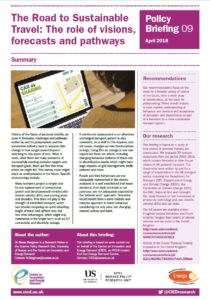A new report published today argues that policy makers need to think more creatively when it comes to anticipating how the transport system might change in the future.
The report, by Centre on Innovation and Energy Demand (CIED) and University of Sussex researcher Noam Bergman, is based on research that found that future scenarios of transport in the UK tend to look very similar to the existing system, rather than consider how disruptive innovations like car sharing or self-driving vehicles might change the way we get around.
The report argues that this approach might have the unintended consequence of shutting out potentially beneficial innovations before they have had a chance to take off. It also puts the resilience of the system at risk by failing to anticipate properly the new challenges and risks that new technologies might bring.
The research shows that forecasting and scenario exercises, written by and for policy makers and the automotive industry, tend to ignore the possibility of fundamental changes to transport systems in the future and instead focus on versions that look similar to how people currently get around – for example simply imagining a switch from petrol- and diesel-powered vehicles to electric vehicles (EVs). These exercises are important because they can encourage investment in a technology and even support policy makers’ course of action.
Planning for a one-for-one replacement of one technology with another, and otherwise assuming an unchanged transport system, is problematic for the following reasons:
- Narrow visions hinder deeper, strategic change to a more sustainable transport system, by locking out more innovative ideas that don’t align with current practices.
- Moreover, if more disruptive innovations (such as automated vehicles or mobility as a service) are not given proper consideration, we risk being underprepared for these challenges.
- A one-for-one replacement is overly simplistic, as there would be wider ramifications to the transport system, from upgrades to the electricity grid to a drop in business for garage forecourts and even a drop in oil demand.
- These visions can actually make it harder for innovations such as EVs to breakthrough, as they have to compete on conventional cars’ terms, rather than playing to their strengths (such as the potential to help balance the electricity grid).
Dr Bergman commented:
‘There is a lack of consideration for disruptive change in the transport system, and this could leave us unprepared for the future. The expectations of seamless continuity are unrealistic.’
The study also criticised the fact that very few of the scenarios imagined a future in which carbon targets were missed – despite the fact that the UK is currently not on course to meet its emission reduction targets in the transport sector.
A third issue identified was the fact that many of the scenarios did not represent the way that people behave when it comes to their transport decisions in a realistic way. The way we travel has a lot to do with habitual behaviour, rather than conscious, calculated decisions. We are also affected by social norms, and we live in a society where high mobility is seen as both a necessity and a right.
When it comes to buying cars, most people prefer tried and tested technology and show brand loyalty, and they don’t always go for what is the cost-effective option. Models need to take this into account, rather than assuming “economically rational” consumers. At the same time, getting people to change their driving habits, walk, cycle or use more public transport, or simply reduce travel, is portrayed as difficult or unrealistic – without being subjected to the “economically rational” test.
‘The selective application of the “rational actor” model is telling, and highlights expectations of continued high travel demand met primarily by privately owned vehicles. This future vision is hard to square with a sustainable transport system,’ explained Dr Bergman.
Looking at two innovations – EVs and car clubs – the study identifies three ways in which planning for the future of transport could be improved:
- Moving from ‘predict and provide’ to an approach taken by the New Zealand Ministry of Transport’s Future Demand project, which considered instead how the New Zealand transport system could or should evolve in order to support mobility in the future;
- Adopting a more sophisticated approach to modelling behaviour in all studies, which is not limited to which car people purchase;
- Considering a broader range of future visions, including scenarios with significant changes to how (and how much) we travel, and those that explore failure to meet emission reductions and other policy targets.
Notes to editors:
- The report is available here: /publication/sustainable-travel-visions/
- The report is based on a study looking at how visions of personal mobility are constructed. The researchers analysed 20 relevant documents, written by and for a range of stakeholders including the Department for Transport (DfT) and the Department of Energy and Climate Change (DECC) and the Committee on Climate Change (CCC).
- Lyons, G. Future Demand: Summary report. (NZ Ministry of Transport, 2014). http://eprints.uwe.ac.uk/24449/1/fd-summary-report.pdf
- CIED, the Centre on Innovation and Energy Demand at the Universities of Sussex, Oxford and Manchester is one of six End Use Energy Demand Centres funded by the Research Councils UK Energy Programme. It sits at the forefront of research on the transition to a low carbon economy. It investigates new technologies and new ways of doing things that have the potential to transform the way energy is used and achieve substantial reductions in energy demand. This report is based on the following two journal articles:
Bergman, N. , Schwanen, T. , Sovacool, B. (2017) Imagined people, behaviour and future mobility: Insights from visions of electric vehicles and car clubs in the United Kingdom. Transport Policy 59 pp.165-173.
Bergman, N. (2017) Stories of the future: Personal mobility innovation in the United Kingdom. Energy Research and Social Science 31 pp.184-193.